When we think about celebratory feasts, herb-crusted prime rib rises to the top of the list. This big, juicy cut is rich. It’s decadent. And it’s absolutely loaded with flavor—especially when crusted with garlic and herbs. Cooking a prime rib also makes many of us nervous to think about, but there’s no need to be intimated. It’s actually super easy to cook, once you learn the proper technique.
The key here comes down to temperature. Overcooked meat becomes dry and tough, so we closely monitor the cooking temperature with a probe thermometer (like the Thermoworks Smoke X). For us, the sweet “done” spot is between medium-rare and medium, but we’ll provide a range of temperatures so you can create the perfect herb-crusted prime rib for your holiday gathering. So, all you really need to do is pop the roast in the oven, sit back with your loved ones, and wait for the timer to let you know it’s time to eat.
What is prime rib?
Prime rib is also known as a standing rib roast. It’s sourced from the rib section of a cow—the same area as ribeye, one of the most well-known types of steak. Ribeyes are cut off the standing rib roast, but prime rib is cooked as a whole roast that’s sliced before serving. This area is prized for its extra-tender texture and gorgeous fat marbling (the streaky white fat that runs throughout a good cut of meat). These cuts pack plenty of flavor on their own, so there’s no need to use a marinade.
Don’t confuse the word “prime” here as the grade of meat. A standing rib roast can come as a prime cut or a choice cut. You can use either, but the different grades of beef affect the rib roast’s quality, taste and cost. Select the one with the best marbling and a nice fat cap, which will “baste” the beef with its own fat as it roasts.
Bone-in or boneless prime rib?
Prime rib generally contains the ribs, so the roast “stands” on the bones—hence the name standing rib roast. We recommend going bone-in for our herb-crusted prime rib. The bones regulate the temperature of the beef as it cooks, ensuring the roast is nice and juicy. It takes a little longer to cook than a boneless prime rib, but it’s well worth it.
The tricky part arises when it’s time to carve. Getting around the bones can be challenging, but we have a way to work around that: Ask your butcher to cut the bone away from the beef and truss the ribs to the roast with butcher’s twine. This butcher-counter tip gives you all the benefits of intact bones, but makes carving much easier. Simply snip off the string, and lift the beef off the bones.
Ingredients for Herb-Crusted Prime Rib
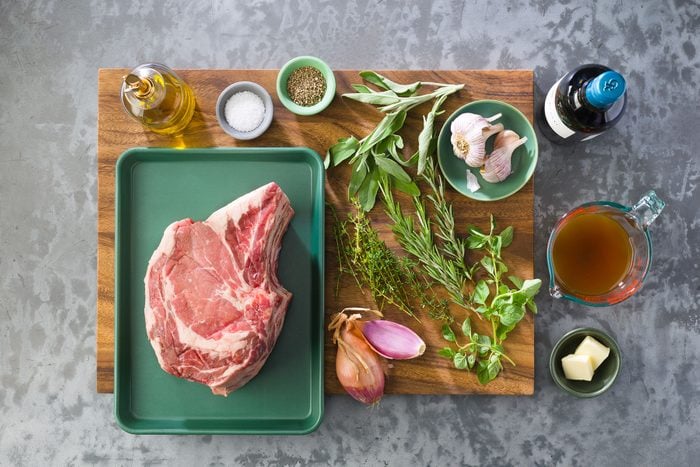
- Bone-in beef rib roast: We use a 4-pound rib roast. Feel free to adjust the quantity based on how much you need. Our Test Kitchen recommends one rib for every two to three guests, depending on how many Christmas side dishes are on the menu. Keep in mind that larger or smaller roasts will have different cooking times.
- Savory herbs: Rosemary, oregano, thyme and sage make up the bulk of our herb crust, and their herbaceous character cuts through the beef’s natural richness. We provide options for using fresh or dried herbs, so you won’t need to worry about calculating a fresh to dried herb conversion.
- Garlic and shallot: These aromatic alliums add a burst of flavor to the herb crust. Give them a rough chop before adding them to the food processor so it’s easier to transform the mixture into a paste.
- Olive oil: Oil is the secret to ensuring the herbs, garlic and shallots adhere to the roast, creating a gorgeous crust that covers every bite of the succulent meat.
- The sauce: Prime rib tastes fantastic on its own, and it’s even better with a sauce like au jus. We make ours with beef broth, dry red wine, butter and salt. You can use additional beef broth if you don’t have wine.
Directions
Step 1: Create the herb rub
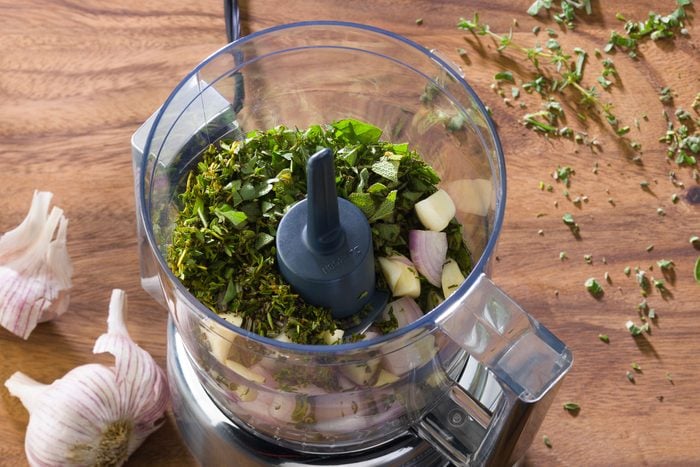
Preheat the oven to 350°F. Place the shallot, garlic, rosemary, oregano, thyme and sage in a food processor. Pulse until finely chopped. Add the olive oil, pepper and salt. Process until the mixture turns into a paste that will easily adhere to the prime rib.
Step 2: Rub the roast
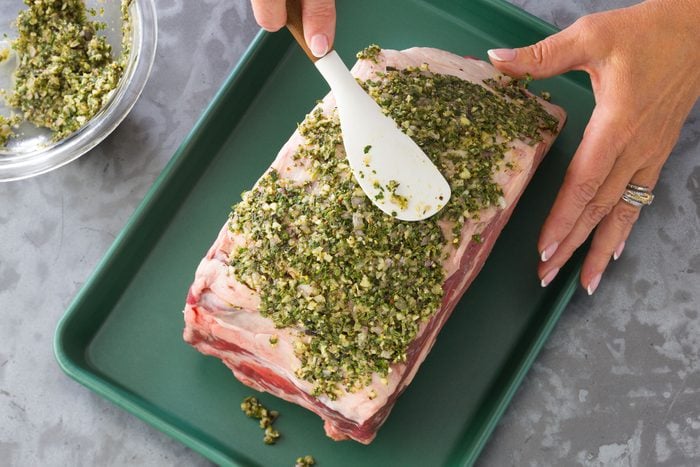
Spread the herb paste evenly all over the roast, doing your best to cover as much surface area as possible. Transfer the roast to a rack set inside a large roasting pan. Place the prime rib to face fat side up. This will bathe the roast in its own flavorful juices as it cooks.
Editor’s Tip: Let the rubbed roast sit at room temperature for 30 minutes to 1 hour before roasting. This takes the chill off the meat surface, which helps the roast brown and cook evenly.
Step 3: Bake the roast
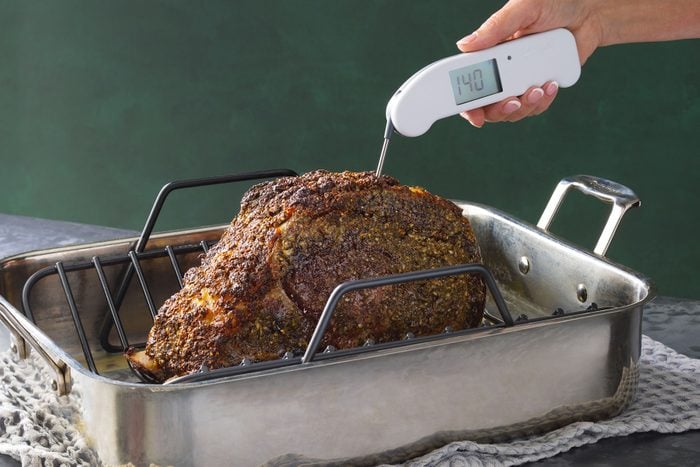
Bake the herb-crusted prime rib, uncovered, until it reaches the desired doneness. Depending on how you like it cooked, this will take 1 hour and 45 minutes to 2 hours and 15 minutes.
| Doneness |
Temperature |
| Medium-Rare | 135° |
| Medium | 140° |
| Medium-Well | 145° |
Editor’s Tip: The meat’s internal temperature will continue to rise as it rests, so remove the roast from the oven when it is 10° below your desired doneness.
Step 4: Let it rest
You may be tempted to slice right into your steamy roast, but first let it rest for at least 15 minutes.
Editor’s Tip: Cutting into meat too early is one of the biggest mistakes people make when cooking steak. The resting period gives the juices time to reabsorb into the meat so it stays juicy and tender.
Step 5: Make the sauce
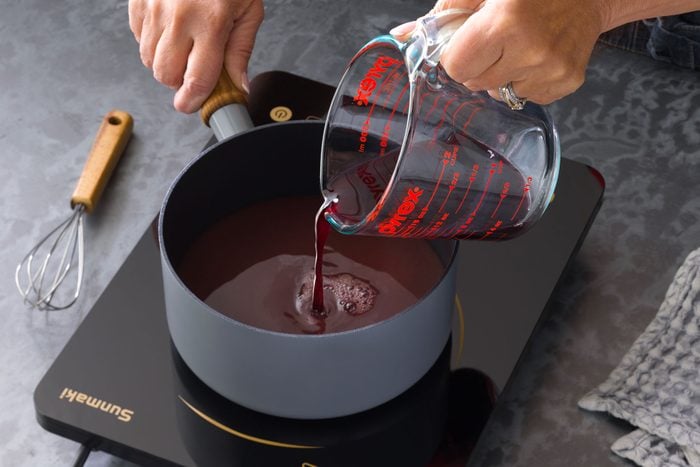
While the roast is resting, pour the beef broth and red wine into a small saucepan. Bring the mixture to a boil, and cook until the liquid is reduced to 1 cup. Remove the pan from heat, then whisk in the butter and salt.
Editor’s Tip: Feel free to supplement some of the beef broth called for with drippings collected from the roasting pan. These pan juices are full of flavor and texture from the beef and its herb coating.
Step 6: Slice and serve
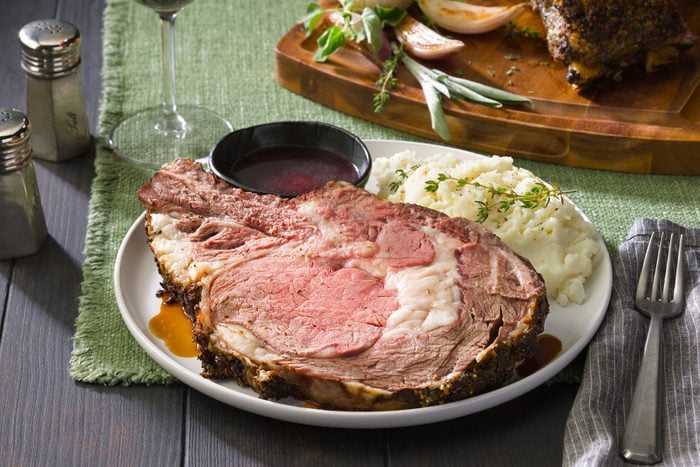
If the bones are still attached to the roast, lift the roast onto its end, using the protruding bones as a handle. Then, glide a sharp knife along the curve of the bones, detaching them from the rest of the meat. Slice the roast to the desired thickness. Serve the herb-crusted prime rib with the prepared sauce.
Editor’s Tip: When asked how to cut steak the right way, we usually recommend cutting against the grain. However, that’s not necessary with prime rib. The grain can be hard to detect, and the meat is so naturally tender on its own, so it’s not something you need to worry about. You’ll end up with a juicy prime rib no matter how you cut.
How to Serve Prime Rib
You can carve prime rib tableside, but we usually slice it in advance. That allows us to cascade the pieces on a large platter, creating an impressive statement when placed in the middle of the Christmas table. If your prime rib is done before you’re ready to serve, wait to slice it. Keep it warm by tenting the roast with a piece of aluminum foil.
Herb-Crusted Prime Rib Variations
- Encase it in salt: You’ll need an entire box of salt to make salt-encrusted prime rib, but we promise it won’t be too salty. The salt forms a crust that locks moisture inside, ensuring the roast turns out juicy.
- Serve with a zesty horseradish sauce: We love the au jus served with this herb-crusted prime rib, but horseradish sauce is a classic accompaniment. In a small bowl, beat 1/2 cup heavy whipping cream until stiff peaks form. Fold in 1/4 cup freshly grated horseradish root, 1/2 teaspoon Dijon mustard and 1/4 teaspoon salt. Cover the sauce, and refrigerate for 15 minutes before serving.
- Freshen it up with a bright gremolata sauce: This Italian condiment adds color and flavor to the roast, really making it pop on the serving platter. Finely chop one bunch of Italian parsley, and combine with the zest of two lemons and one minced garlic clove. Store in an airtight container in the refrigerator until ready to serve.
How to Store Herb-Crusted Prime Rib
If you love a good roast beef sandwich, you’re in luck! Prime rib leftovers are good in the fridge for up to four days, or up to four months in the freezer. Whichever storage method you choose, tightly wrap the meat in storage wrap first. It tastes best (and stays juiciest) when freshly sliced, so we recommend storing the roast whole.
Thaw prime rib overnight in the refrigerator. When you’re ready to eat, slice the roast, and use your preferred method for reheating steak to warm the slices through.
Herb-Crusted Prime Rib Tips
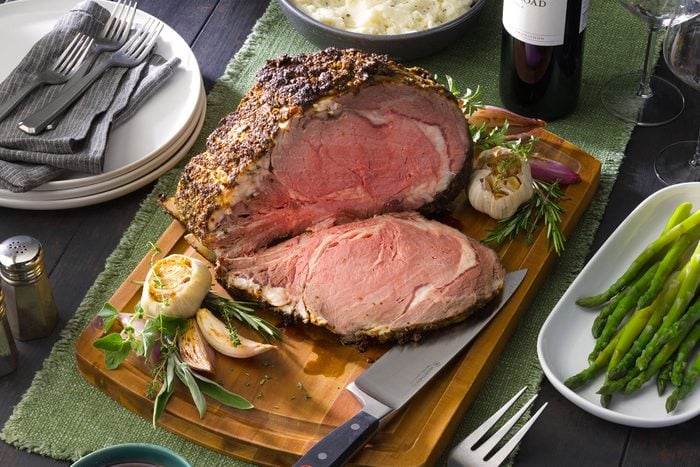
How long does it take to cook prime rib?
A 4-pound prime rib roast takes around two hours in a 350° oven. Prime rib cooking time varies based on the size of the standing rib roast, the temperature of the oven, and the desired level of doneness. The best way to know—not guess—when the roast is finished cooking is to use an instant-read thermometer.
What are the best sides for prime rib?
Any side dish that goes well with steak will taste great with herb-crusted prime rib. Look to classic potato dishes like mashed potatoes or au gratin potatoes. Most vegetables work well here, especially air-fryer Brussels sprouts or a classic salad like Caesar salad. For an extra-decadent meal, serve prime rib with rich sides like creamy macaroni and cheese.
What is the best way to get prime rib cooked?
Most rib roast recipes use large roasting pan, but our Test Kitchen finds a 13×9-inch dish works, too. If you’re opting for this rack-free baking pan, layer the bottom with veggies, and place your roast on top. We’d recommend a mirepoix, a fancy French term for coarsely chopped onions, carrots and celery. The veggies will cook gently and help form a flavorful sauce from your drippings.
